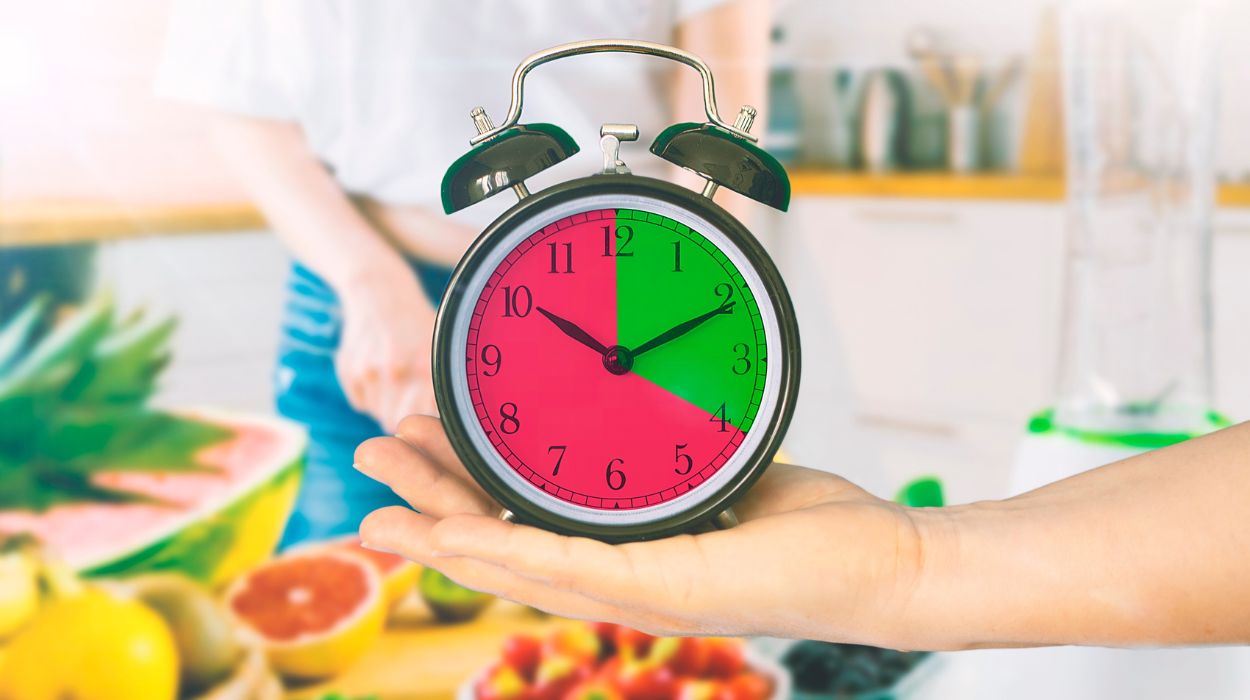 Expert's opinion
Expert's opinion
Expert's opinion
The article is a subjective view on this topic written by writers specializing in medical writing.
It may reflect on a personal journey surrounding struggles with an illness or medical condition, involve product comparisons, diet considerations, or other health-related opinions.
Although the view is entirely that of the writer, it is based on academic experiences and scientific research they have conducted; it is fact-checked by a team of degreed medical experts, and validated by sources attached to the article.
The numbers in parenthesis (1,2,3) will take you to clickable links to related scientific papers.
Intermittent Fasting For Women: Quick Start Guide & What To Know 2024

Time-restricted eating, also known as intermittent fasting, is a lifestyle choice wherein the individual restricts her food intake to a certain “window” of the day—one example might be eating meals throughout the early afternoon and evening, choosing to fast throughout the night and early morning.
It can be really good for you, but many women fear repercussions in terms of their reproductive health. Is intermittent fasting safe for women? Will it lead to a disordered eating pattern, especially if one were predisposed to this particular dysfunction?
One of the many health benefits of any controlled fast will inevitably be a newfound relationship with the food that you eat. Even if you’ve struggled with eating disorders in the past, a renewed sense of clarity regarding your food may help you see the light.
What To Know About Intermittent Fasting For Women
Daily fasting, alternate-day fasting, and other intermittent fasting methods will not only protect you from a myriad of chronic diseases—but they’re also much more adaptable to your needs and preferences than many other diets of this caliber and efficacy. However, it is again noted that the best way to implement these plans is in agreement with your circadian rhythm. However, vegans, keto fans, early-morning eaters, and even late-night warriors should all be able to come up with fasting plans that suit the particularities of each lifestyle.
Pros And Cons Of Intermittent Fasting For Women
Daily fasting, alternate-day fasting, and other intermittent fasting methods will not only protect you from a myriad of chronic diseases—but they’re also much more adaptable to your needs and preferences than many other diets of this caliber and efficacy. However, it is again noted that the best way to implement these plans is in agreement with your circadian rhythm. However, vegans, keto fans, early-morning eaters, and even late-night warriors should all be able to come up with fasting plans that suit the particularities of each lifestyle. What else do you have to look forward to?
Some studies[1] have concluded that losing weight is no more successful with intermittent or alternate-day fasting than with any other calorie-restriction diet, i.e., that it’s just another way to diet, and that any diet–done successfully–will work.
Pros
For the intermittent fasting diet, however, a few key health benefits to keep in mind, including many for heart health:
- Intermittent fasting can help you burn fat, reduce calorie intake, and avoid unhealthy processed foods, preventing[2] weight gain
- An intermittent diet can also help you prevent[3] health issues like heart disease[4] and might even be able to help you lower blood pressure and prevent chronic inflammation of the inner walls of the arteries
- During each fast[5], you’ll enjoy lower circulating cholesterol levels, blood sugar levels, and improved insulin sensitivity
- Fasting is neuroprotective[6] and may even have a positive impact on your mental health
Cons
It sounds great, but it’s not all roses, as with anything. Some of the risks and cons associated with intermittent fasting:
- As mentioned above, a restricted energy intake will often cause a myriad of female reproductive issues, such as low reproductive hormones and missed periods
- Some may find this type of lifestyle difficult to adapt to before becoming totally used to it
- Those involved in shift work or very physical occupations might find themselves under-eating for their professional needs, or otherwise unable to eat during a consistent daily feeding window
- Fasting might make you prone to irritability[7] if you’re not used to limiting yourself to only eating at certain times of the day
If you are a woman of reproductive age who isn’t actively trying to conceive, there is no reason to deny yourself a shot at intermittent fasting. Your reproductive cycle is very dynamic and forgiving; any alterations to your ovulation or menstrual cycle will always be temporary. If you can ensure that your daily diet meets your nutritional needs overall, you’re unlikely to cause your reproductive system any long-term harm. The same can certainly be said for intermittent fasting for women over 40—your body still has needs to attend to, and all of these needs can be compartmentalized into an intermittent fasting or alternate-day fasting plan that suits you.
A fasting diet rich in healthy fats, generous amounts of protein, and enough carbohydrates to keep you moving is the perfect way to regulate insulin levels and blood glucose levels, decrease body fat, improve heart health, and improve your metabolic health. You’ll likely lose weight, and you’ll end up feeling amazing in the process.
Just remember that these benefits are a result of losing weight at all and not necessarily the way you do it. So why bother experimenting with intermittent fasting or alternate-day fasting? The answer to this is that everyone is different; what may be the perfect diet strategy for you may not be the one for your neighbor. Also, a diet may remain the same, but you change. Therefore, what may be the perfect diet for you today may not work in a few months. So, the benefit of intermittent fasting or alternate-day fasting is not their superiority, but their candidacy as additional ways to succeed when other diets may have failed.
What Is Intermittent Fasting?

Intermittent fasters adhere to a diet focused less on the “what” of every meal and more on the “when”[8]. You’ve got a fasting window and an eating window. During your fasting window, you’re advised to restrict calories entirely, eating and drinking nothing but water in most cases.
How long is a fasting period? It depends. Many people believe that a 16-hour window is ideal for most average fasters, with some deviation up and down depending on work, school, lifestyle, and preference. 24-hour fasts are also quite common on a weekly, semi-weekly, or alternate-day basis.
Do you feel hungry when intermittent fasting? Most colloquial accounts online attest to the body’s ability to acclimate itself[9] after being on the diet for some time. After-meal satiety improves greatly, and the urge to eat during your off-hours tends to fade greatly with time.
To the average American, intermittent fasting plans like these often come across as restrictive to the point of being psychotic. There’s a huge historical legacy validating the benefits of intermittent fasting, however, especially in Ayurvedic medicine. The digestive fire rages on unabated without our favorite late-night treat slowing it down; it’s unthinkable for many, but it’s rational and likely to be the truth.
Through your fasting hours, the body is cleansed of toxins and impurities when you give it the time and the space to contend with everything already gunking it up, but don’t take our word on it. These are results that you’ll both see and feel.
Does Fasting Affect Men And Women Differently?
In a big-picture sense, men and women stand to benefit from an intermittent eating plan in many of the same ways. They generally lose about the same amount of weight[10] even when following identical intermittent diets. Gender also has little to do with fasting’s impact on fat mass, lean muscle mass, fasting insulin, insulin resistance, and blood pressure.
Clearly, most men and women will have different priorities in terms of how they engage in their diet to maintain themselves. Reproductive health is one obvious example—a man skips a meal and can generally just let it roll off of his back. Many women, however, value the fertile vessel of the body deeply, eating intuitively in a way that might turn them off to the concept of restrictive fasting windows.
Calorie restriction, whether through fasting and non-fasting periods or otherwise, has been shown to have a powerful effect on the menstrual cycle[11].
Some animal studies back this notion, illustrating a reduction in fertility and a disrupted estrous cycle[12], the critical period of time when the female body ovulates—i.e. when a woman is “in heat.” Starvation locks the female into the diestrous phase of the monthly reproductive cycle, and a new egg may end up failing to drop (ovulate)
Other animal studies attest to the opposite[13]—that a fasting window actually increases fertility and rates of reproduction. While we’re always up for a rousing debate, the controversy might make designing your own eating plan difficult.
Changing your eating patterns dramatically in any way will invariably[14] impact the way that your body produces and secretes female hormones, which may cause its own share of issues in terms of a woman’s reproductive health. The hypothalamus-pituitary-ovarian axis, or HPO for short[15], is the system by which your body regulates your appetite as it responds to reproductive demand. Calorie restriction, a negative energy balance, inhibits this signaling system, which might sometimes leave the female body in want.
A major consideration of infertility is that your body and its many functions follow a circadian rhythm. Thus, establishing eating and fasting windows may conflict with this rhythm. We’ve all evolved on a planet that spins on its axis, so all of our functions have thrived on a night-and-day schedule. This includes everything from thyroid hormones to melatonin and the hormones that drive the HPO axis. If intermittent fasting were to conflict with your circadian rhythm, your diet may not garner optimum results. It’s been shown in the medical literature that if intermittent fasting is aligned with your circadian[16] (wake/sleep) cycle, weight loss can occur as well as improvement of your metabolism[17], i.e., reduced oxidative stress, improved cognition, delayed aging, anti-inflammatory effects, and improvement of your the gut microbiome for digestive benefits.
Another consideration about your rhythm: a lack of sleep has been found to increase ghrelin (an appetite stimulant) and lower leptin (an appetite inhibitor). All circadian rhythms center on sleep is adequate[18]. Leptin is also important for a normal menstrual cycle, so dieting can affect your leptin levels which secondarily can affect your cycle[19].
Thus, women attempting pregnancy, pregnant women (or even breastfeeding women), in the vast majority of cases, shouldn’t be fasting. When in doubt, it never hurts to consult your attending physician.
Is Intermittent Fasting Safe For Women?
Does intermittent fasting work for weight loss? There is no question that millions of women have found a lot of success through an intermittent fasting meal plan. Those embarking on one of the most important journeys of a woman’s life, motherhood, have much bigger fish to fry, however. Weight loss will never be one of them during this contentious time.
If you tend to skip breakfast, you might already be subject to a completely valid fasting period. Learn as much as you can about this lifestyle if it interests you—intermittent fasting for gut health, fat loss, and a healthy lifestyle overall will be one of the best decisions you ever make in your life. If you’re pregnant or trying to get pregnant, though, we recommend waiting until your body is truly yours again.
+ 19 sources
Health Canal avoids using tertiary references. We have strict sourcing guidelines and rely on peer-reviewed studies, academic researches from medical associations and institutions. To ensure the accuracy of articles in Health Canal, you can read more about the editorial process here
- Trepanowski, J.F., Kroeger, C.M., Barnosky, A., Klempel, M.C., Bhutani, S., Hoddy, K.K., Gabel, K., Freels, S., Rigdon, J., Rood, J., Ravussin, E. and Varady, K.A. (2017). Effect of Alternate-Day Fasting on Weight Loss, Weight Maintenance, and Cardioprotection Among Metabolically Healthy Obese Adults. JAMA Internal Medicine, [online] 177(7), p.930. Available at: https://pubmed.ncbi.nlm.nih.gov/28459931/
- Rynders, C.A., Thomas, E.A., Zaman, A., Pan, Z., Catenacci, V.A. and Melanson, E.L. (2019). Effectiveness of Intermittent Fasting and Time-Restricted Feeding Compared to Continuous Energy Restriction for Weight Loss. Nutrients, [online] 11(10), p.2442. Available at: https://www.ncbi.nlm.nih.gov/pmc/articles/PMC6836017/
- Wan, R., Ahmet, I., Brown, M., Cheng, A., Kamimura, N., Talan, M. and Mattson, M.P. (2010). Cardioprotective effect of intermittent fasting is associated with an elevation of adiponectin levels in rats. The Journal of Nutritional Biochemistry, [online] 21(5), pp.413–417. Available at: https://pubmed.ncbi.nlm.nih.gov/19423320/
- Trepanowski, J.F., Kroeger, C.M., Barnosky, A., Klempel, M.C., Bhutani, S., Hoddy, K.K., Gabel, K., Freels, S., Rigdon, J., Rood, J., Ravussin, E. and Varady, K.A. (2017). Effect of Alternate-Day Fasting on Weight Loss, Weight Maintenance, and Cardioprotection Among Metabolically Healthy Obese Adults. JAMA Internal Medicine, [online] 177(7), p.930. Available at: https://pubmed.ncbi.nlm.nih.gov/28459931/
- Khan (2021). Effects of Ramadan fasting on glucose levels and serum lipid profile among type 2 diabetic patients. Saudi medical journal, [online] 31(11). Available at: https://pubmed.ncbi.nlm.nih.gov/21063662/
- Gudden, J., Arias Vasquez, A. and Bloemendaal, M. (2021). The Effects of Intermittent Fasting on Brain and Cognitive Function. Nutrients, [online] 13(9), p.3166. Available at: https://www.ncbi.nlm.nih.gov/pmc/articles/PMC8470960/
- Watkins, E. and Serpell, L. (2016). The Psychological Effects of Short-Term Fasting in Healthy Women. Frontiers in Nutrition, [online] 3. Available at: https://www.ncbi.nlm.nih.gov/pmc/articles/PMC4992682/
- Welton, S., Minty, R., O’Driscoll, T., Willms, H., Poirier, D., Madden, S. and Kelly, L. (2020). Intermittent fasting and weight loss: Systematic review. Canadian family physician Medecin de famille canadien, [online] 66(2), pp.117–125. Available at: https://www.ncbi.nlm.nih.gov/pmc/articles/PMC7021351/
- Ravussin, E., Beyl, R.A., Poggiogalle, E., Hsia, D.S. and Peterson, C.M. (2019). Early Time‐Restricted Feeding Reduces Appetite and Increases Fat Oxidation But Does Not Affect Energy Expenditure in Humans. Obesity, [online] 27(8), pp.1244–1254. Available at: https://pubmed.ncbi.nlm.nih.gov/31339000/
- Lin, S., Oliveira, M., Gabel, K., Kalam, F., Cienfuegos, S., Ezpeleta, M., Bhutani, S. and Varady, K.A. (2021). Does the weight loss efficacy of alternate day fasting differ according to sex and menopausal status? [online] 31(2), pp.641–649. doi:https://doi.org/10.1016/j.numecd.2020.10.018.
- Meczekalski, B., Katulski, K., Czyzyk, A., Podfigurna-Stopa, A. and Maciejewska-Jeske, M. (2014). Functional hypothalamic amenorrhea and its influence on women’s health. Journal of Endocrinological Investigation, [online] 37(11), pp.1049–1056. Available at: https://pubmed.ncbi.nlm.nih.gov/25201001/
- Kumar, S. and Kaur, G. (2013). Intermittent Fasting Dietary Restriction Regimen Negatively Influences Reproduction in Young Rats: A Study of Hypothalamo-Hypophysial-Gonadal Axis. PLoS ONE, [online] 8(1), p.e52416. Available at: https://www.ncbi.nlm.nih.gov/pmc/articles/PMC3558496/
- Hua, L., Feng, B., Huang, L., Li, J., Luo, T., Jiang, X., Han, X., Che, L., Xu, S., Lin, Y., Fang, Z., Wu, D. and Zhuo, Y. (2020). Time‐restricted feeding improves the reproductive function of female mice via liver fibroblast growth factor 21. Clinical and Translational Medicine, [online] 10(6). Available at: https://www.ncbi.nlm.nih.gov/pmc/articles/PMC7533054/
- Kim, B.H., Joo, Y., Kim, M.-S., Choe, H.K., Tong, Q. and Kwon, O. (2021). Effects of Intermittent Fasting on the Circulating Levels and Circadian Rhythms of Hormones. Endocrinology and Metabolism, [online] 36(4), pp.745–756. Available at: https://pubmed.ncbi.nlm.nih.gov/34474513/
- Sun, J., Shen, X., Liu, H., Lu, S., Peng, J. and Kuang, H. (2021). Caloric restriction in female reproduction: is it beneficial or detrimental? Reproductive Biology and Endocrinology, [online] 19(1). Available at: https://www.ncbi.nlm.nih.gov/pmc/articles/PMC7780671/
- Longo, V.D. and Panda, S. (2016). Fasting, Circadian Rhythms, and Time-Restricted Feeding in Healthy Lifespan. Cell Metabolism, [online] 23(6), pp.1048–1059. Available at: https://pubmed.ncbi.nlm.nih.gov/27304506/
- Stockman, M.-C., Thomas, D., Burke, J. and Apovian, C.M. (2018). Intermittent Fasting: Is the Wait Worth the Weight? Current Obesity Reports, [online] 7(2), pp.172–185. Available at: https://pubmed.ncbi.nlm.nih.gov/29700718/
- Sleep Foundation. (2020). Can Overeating Cause Sleep Disturbances? | Sleep Foundation. [online] Available at: https://www.sleepfoundation.org/physical-health/sleep-and-overeating [Accessed 14 Apr. 2022].
- Chan, J.L. and Mantzoros, C.S. (2005). Role of leptin in energy-deprivation states: normal human physiology and clinical implications for hypothalamic amenorrhoea and anorexia nervosa. The Lancet, [online] 366(9479), pp.74–85. Available at: https://pubmed.ncbi.nlm.nih.gov/15993236/



